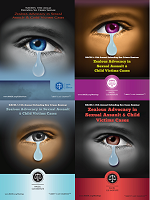Access to The Champion archive is one of many exclusive member benefits. It’s normally restricted to just NACDL members. However, this content, and others like it, is available to everyone in order to educate the public on why criminal justice reform is a necessity.
According to a recent report by a study group of the Pew Charitable Trusts, more than 1 in 100 Americans is currently behind bars.1 When the figures are broken down by age, sex and race, the statistics are as stunning as a slap in the face: 1 in 9 black males aged 20 to 34 is incarcerated. One in 72 of all males is in jail or prison. One in 96 of all Hispanics is doing time. The Pew Center found that 1 in 746 women is incarcerated, but broken down by age and race, 1 in 100 black women aged 35-39 and 1 in 297 Hispanic women are doing time, compared to 1 in 355 for white women in the same age group.
But according to other recent studies, the fastest growing prison demographic is women. Silja Talvi, in her new book Women Behind Bars, notes that the number of incarcerated adult women has jumped 757 percent since 1977, nearly twice the growth rate for men.2 And most of these women are mothers, Talvi writes.
Almost two and one-half million children have a parent in prison. Many women are incarcerated while pregnant, or become pregnant (usually by a male correctional officer) while imprisoned, and deliver their babies in shackles. Then their babies are taken away from them.
Talvi neither exploits nor minimizes the abuse of women (and men and juveniles) behind bars. She forcefully presents it for what it is — a violation of human rights pervasive throughout the state and federal prison systems. In the rest of the Western world, which has far fewer women behind bars in the first place, women prisoners are guarded by other women. That’s the way it used to be here too. Male correctional officers in women’s prisons were generally assigned to the perimeter and the gate, or were senior supervisors.
But as civil rights legislation, such as the Equal Employment Opportunity Act of 1972, provided for equal rights according to sex, “correctional officer” became a gender-neutral job position, and men moved into closer contact with women in prison, with predictably unintended consequences. Today, one in four women reports being sexually abused while in prison or jail. Formal complaints against officers or other inmates, however, are frequently rebuffed as fabrications or “consensual” encounters, discouraging reporting. Fear of retribution also contributes to a low official reporting rate.
Instead of discouraging abuse by punishing abusers, correctional facilities take a “preventive” approach, practically eliminating any psychological sense of privacy with bright lights, metal mirrors and surveillance cameras, even in showers and cells. The guards need not actually watch the inmates; rather, the inmate is made to feel as if she is under constant surveillance and is supposed to behave accordingly. She does not, however, feel “safer” as a consequence of these constant intrusions.
And while female-on-female sexual assaults occur, Talvi reports only about a half-dozen of her interviewees confided that they were forced into a sexual situation with another inmate or female guard. The “vast majority” of sexual contact and sexual violence in women’s prisons happen when male correctional employees exploit the gender and power differentials inherent in a female custodial setting, she says.
“The sexually intrusive or abusive nature of these experiences in prison has a devastating impact on a woman’s likelihood of achieving a healthy and successful re-entry into society,” posits Talvi. That is hard to dismiss. Prisons in general are mentally and physically unhealthy places.
Talvi recounts the story of one woman she met at Central California Women’s Facility who was sentenced to life in prison for a $200 unarmed robbery. When Gina Muniz was first taken to the L.A. County Jail, she began to bleed, all over herself and her cell. Deputies were so disgusted they threw whole rolls of toilet paper, a precious commodity in the jail, into her cell. It was eight months before she got a proper examination and was diagnosed with Stage IIB cervical cancer.
Falling into depression after the death of her father, she began to use cocaine. Eventually she became dependent on it. With traffic misdemeanors as her only criminal record, she pleaded guilty to the robbery, expecting a short sentence. Instead, she got life, a sentence she said she did not understand until she was processed at CCWF.
In Muniz’s case, life meant her life. Medical decisions made at some level in the process denied her the necessary hysterectomy, radiation, and chemotherapy that could have saved her. In essence, she was sentenced again to months of pain and suffering, handcuffed to a bed at a community hospital. The San Francisco-based advocacy group Legal Services for Prisoners with Children successfully petitioned for a furlough so that she could die at her mother’s home. She did, two days after her release.
Her mother, Grace Ortega, became a women prisoners’ advocate, speaking to legislators and community groups about her daughter, hoping to prevent such future suffering.
Talvi’s book tells individual stories of women behind bars, from adolescents in juvenile facilities to older women who have spent the best part of their lives in prison. Her interviews force us to think about these women not as criminals paying their debts for the conduct, but human beings who have been taken from lives of abuse in the free world to lives of abuse by the system.
She offers no solutions. But by forcing us to face the day-to-day humiliation and despair of these prisoners, she hopes that society will find a way to bring them some dignity and hope, and prepare them for a better life on the outside.
To do that, the United States has to get a grip on its obsession with incarceration. According to the Pew Report, the United States has more inmates than the 26 most populous European nations.3 The United States, with 5 percent of the world’s population, has 25 percent of the world’s prisoners.
Is the rest of the world out of step, or are we nuts?
Notes
- The Pew Center on the States, One in 100: Behind Bars in America 2008 (February 2008). The actual incarceration rate, according to the report, is 1 in every 99.1 adults.
- Silja J.A.Talvi, Women Behind Bars: The Crisis of Women in the U.S. Prison System xv (Seal Press 2008), citing Natashia A. Frost, Judith Greene and Keven Pranis, Hard Hit: The Growth in the Imprisonment of Women, 1977-2004 9 (2006).
- One in 100, supra, 35. The U.S. inmate population in 2007 was 2,245,189. The 26 European countries had a total of 1,842,115. By comparison, the Russian Federation had 889,598 behind bars, and England and Wales had a total combined prisoner population of 80,229.






